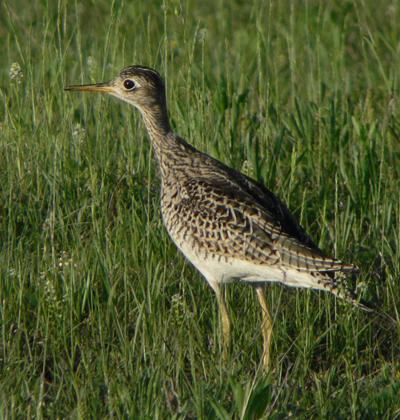
by John Shackford
I love hearing the Upland Sandpipers (Bartramia longicauda) calling as they fly overhead at night in fall and spring: Oodle-oo (3 syllables) is what it sounds like to me, although it appears some ornithologists show this call with 4 syllables. The night time calls are a pleasant reminder that birds are on the move and the seasons are changing. In the fall, these birds arrive from the north “from June 30 to October 25,” according to Sutton (Oklahoma Birds, 1967).
I spent a memorable half hour one spring looking into a field less than a quarter mile east of Rose Lake, in Canadian County. I found a flock of Upland Sandpipers some distance away from the road, far enough away to need a scope to check them out reasonably well. As I was scanning through the group, I saw a brown bird with a definitely decurved bill. This raised the possibility of an extremely rare look at an Eskimo Curlew, a bird believed to be on the brink of extinction at the time. But if any existed, central Oklahoma would be a credible place to see one during migration. I worked and worked to determine definitely whether it was a curlew or an Upland Sandpiper with a decurved bill. Finally I was able to conclude that it was an Upland Sandpiper with a deformed, but very symmetrically curved, bill. Such are the vagaries of bird identification.
Bent (1927, Life Histories of North American Shore Birds) said that “extensive shooting for the market, where it was much in demand, reduced its numbers to an alarmingly low ebb.” Dr. Thomas S. Roberts (1919, Water Birds of Minnesota Past and Present), as quoted in Bent, said that in Minnesota “fifty years ago it was present all through the summer, everywhere in open country, in countless thousands. Now [1919] it is near extinction.” Fortunately numbers have rebounded so that now they are fairly common migrants in central Oklahoma where we see them in fields or hear them call overhead.
The breeding grounds of the Upland Sandpiper are found in the northern half of the United States from the east coast west to northern Oklahoma and most of Kansas, then northwestward to Alaska. Upland Sandpipers that regularly breed in Oklahoma are usually found in the northeastern part of the state. It is one of the special birds to be found nesting among the grasses of The Nature Conservancy’s Tallgrass Prairie Preserve. Nesting birds usually lay 4 eggs.
Dr. Elliott Coues (1874, Birds of the North-West), as reported in Bent (1927) tells of an instance of remarkable bravery of a parent Upland Sandpiper in defense of a young chick he had caught. “I never saw a braver defense attempted than was made by this strong-hearted though powerless bird, who, after exhausting her artifices to draw me in pursuit of herself, by tumbling about as if desperately wounded, and lying panting with outstretched wings on the grass, gave up hope of saving her young in this way, and then almost attacked me, dashing close up and retreating again to renew her useless onslaught.” What a difference from the quiet, reserved migrants we normally see in our Oklahoma fields.
These sandpipers winter on the pampas of South America, which are found on the lower east side of the continent, in southern Brazil, most of Uruguay, and northeastern provinces of Argentina. From these pampas the Upland Sandpipers head northward, reaching Oklahoma in the spring, according to Sutton (1967) “from March 21 to late May.” The total flight distance between winter grounds and breeding grounds for many of these birds is some 7000 miles.
